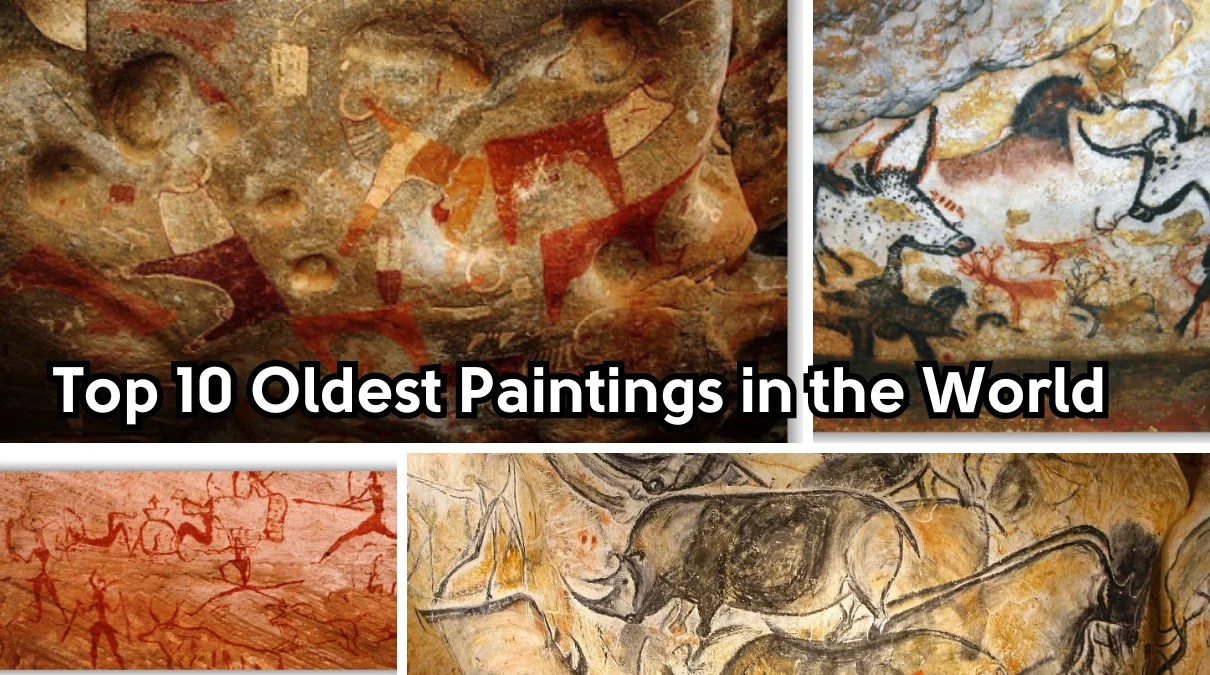Top 10 Oldest Paintings in the World
Art is one of the earliest forms of human expression, dating back tens of thousands of years. The oldest paintings in the world offer us a glimpse into the minds of our ancestors, showcasing their creativity, beliefs, and connection to the world around them.
These ancient artworks, found in caves, rocks, and other hidden corners of the earth, continue to fascinate historians, archaeologists, and art lovers. In this article, we’ll explore the top 10 oldest paintings in the world and what makes each one a remarkable piece of history.
#1. Chauvet Cave Paintings – France (30,000 – 32,000 years old)

The Chauvet Cave, located in southern France, is home to some of the earliest known paintings in human history. Discovered in 1994, these stunning images are thought to be between 30,000 and 32,000 years old.
The paintings mainly depict animals such as lions, horses, mammoths, and rhinoceroses, all rendered with incredible detail. What makes these paintings stand out is their use of shading and perspective, suggesting that even ancient humans had a sophisticated understanding of artistic techniques.
The Chauvet Cave paintings are significant not just because of their age, but also because of the insights they provide into the early artistic skills of humans. The detail and accuracy in the animal depictions suggest that these early artists observed nature closely and were skilled at recreating it.
Significance:
- One of the oldest and most well-preserved cave paintings.
- Shows advanced techniques like shading and perspective.
#2. Lascaux Cave Paintings – France (17,000 years old)

Another gem from France, the Lascaux Cave paintings, are estimated to be around 17,000 years old. Discovered in 1940, the caves are famous for their 600 wall paintings, primarily of animals like bulls, horses, and stags.
These images are painted using natural pigments in vibrant colors, including reds, blacks, and yellows.
What sets the Lascaux paintings apart is their sense of movement. The animals seem to leap off the walls, with their dynamic poses and the way they are grouped together creating a sense of storytelling. The caves are often referred to as the “Sistine Chapel of Prehistoric Art.”
Significance:
- Famous for its vibrant and dynamic animal depictions.
- Considered a masterpiece of prehistoric art.
#3. El Castillo Cave Paintings – Spain (40,800 years old)

Located in northern Spain, the El Castillo Cave holds one of the oldest known examples of human art. Dated at around 40,800 years old, the paintings include hand stencils and simple red disks made by blowing paint onto the wall. Some researchers believe these may have been created by Neanderthals, though this is still debated.
The handprints are especially intriguing, as they offer a direct connection to the individual who made them, providing a hauntingly personal link to the distant past. These early works of art are among the oldest confirmed paintings by ancient humans in Europe.
Significance:
- Oldest cave paintings in Europe.
- Possibly created by Neanderthals.
#4. Altamira Cave Paintings – Spain (35,000 – 14,000 years old)

Discovered in 1868, the Altamira Cave in northern Spain contains vibrant images of bison, deer, and horses.
The paintings are believed to have been created between 35,000 and 14,000 years ago, with most of the art being closer to the more recent date. The artists used natural pigments like ochre and charcoal to create their images.
The Altamira paintings are particularly famous for their impressive use of polychrome painting, where multiple colors were used to add depth and realism to the animals. The bison, with their three-dimensional appearance, seem almost alive.
Significance:
- First cave paintings to be recognized as prehistoric.
- Known for its polychrome style and lifelike animal representations.
#5. Sulawesi Cave Paintings – Indonesia (at least 39,900 years old)

In Indonesia, on the island of Sulawesi, archaeologists discovered ancient hand stencils and depictions of wild animals, believed to be at least 39,900 years old.
These paintings are some of the oldest known examples of figurative art in the world. The hand stencils are similar to those found in Europe, suggesting that early humans may have shared artistic practices across great distances.
The depiction of wild animals, such as anoas (a type of buffalo), adds to the importance of these cave paintings, offering insights into the wildlife that ancient humans encountered.
Significance:
- Oldest known example of figurative art.
- Provides evidence of early human presence in Southeast Asia.
#6. Apollo 11 Cave Stones – Namibia (25,000 years old)

In southern Africa, the Apollo 11 Cave in Namibia is home to some of the oldest mobile art in the world. These stone plaques, dated to around 25,000 years ago, feature images of animals that were etched and painted onto slabs of stone. They are unique because they are portable, unlike the fixed cave paintings found in other parts of the world.
These images offer a glimpse into the spiritual and cultural life of early humans in Africa, suggesting that art was not just a form of decoration but had deeper symbolic meanings.
Significance:
- One of the oldest examples of African art.
- Offers insight into the mobile art culture of early humans.
#7. Bhimbetka Rock Shelters – India (30,000 years old)

The Bhimbetka Rock Shelters, located in central India, are home to ancient paintings that date back as far as 30,000 years. These rock shelters are part of a UNESCO World Heritage site and contain thousands of paintings. The images depict human figures, animals, and hunting scenes.
The paintings use simple lines and shapes to create figures, but they also show a rich variety of subjects, indicating the early human fascination with the natural world and daily life.
Significance:
- One of the oldest known examples of art in India.
- Contains a vast array of subjects, from animals to human activities.
#8. Tadrart Acacus Rock Art – Libya (12,000 years old)

The Tadrart Acacus is a mountain range in the Sahara Desert of Libya, home to ancient rock art dating back 12,000 years. These paintings depict a wide range of subjects, including humans, animals, and abstract symbols. The changing styles and subjects over time reflect the shifting environment and cultures of the region.
The art of Tadrart Acacus is unique for its portrayal of both wildlife and the daily lives of the early desert people, offering insights into the interactions between humans and their environment.
Significance:
- Represents changing lifestyles in the Sahara over millennia.
- Offers detailed depictions of early Saharan life.
#9. Ubirr Rock Art – Australia (20,000 years old)

The Ubirr Rock Art site, located in Kakadu National Park in northern Australia, contains some of the world’s oldest and most significant Aboriginal rock paintings, dating back as far as 20,000 years. The images depict animals, such as fish and kangaroos, as well as intricate human figures and abstract designs.
One of the most striking aspects of Ubirr art is its X-ray style, where animals are depicted with their internal organs visible, highlighting the Aboriginal people’s deep understanding of the anatomy of the creatures they relied on for survival.
Significance:
- Contains unique X-ray style depictions of animals.
- A key site for understanding Aboriginal culture and history.
#10. Laas Geel Cave Paintings – Somalia (9,000 years old)

The Laas Geel Cave complex in Somaliland, dating back to 9,000 years ago, contains some of the best-preserved rock art in Africa. The paintings depict cattle in ceremonial scenes, along with humans and other animals, all rendered in vivid reds and oranges.
These paintings offer valuable insights into the lives of the pastoralist societies that once thrived in the Horn of Africa, showing the importance of livestock to these early people.
Significance:
- Some of the best-preserved rock art in Africa.
- Provides insights into ancient pastoralist cultures.







